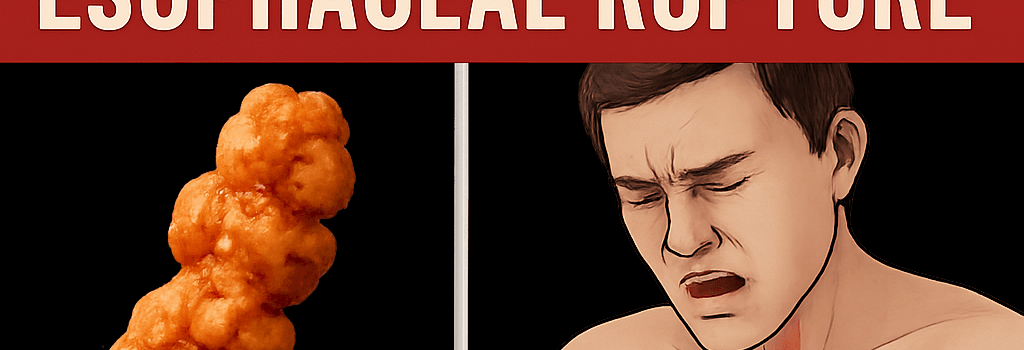Street Food Reaction Causes Rare Esophageal Rupture

Case Overview
Foodborne illness is typically unpleasant, but for a 59-year-old man in Qingdao, China, it evolved into a near-fatal medical emergency. According to a New England Journal of Medicine case report by Drs. Penghui Wei and Wenyong Zhu, the patient ingested questionable street food and within hours experienced violent retching and vomiting so forceful it perforated his esophagus—a condition known as Boerhaave syndrome.
Clinical Presentation and Emergency Response
- Time to presentation: 5.5 hours post-ingestion.
- Symptoms: Sudden, severe chest pain exacerbated by respiration; tachypnea (respiratory rate ~28 breaths/min); subcutaneous emphysema (“rice-krispie” crackling) in neck; diminished breath sounds at right lung base.
- Initial management: High-flow oxygen, IV broad-spectrum antibiotics to cover oral flora and mediastinal contamination, fluid resuscitation.
Diagnostic Imaging and Findings
A high-resolution CT scan (1-mm slice thickness) revealed:
- Pneumomediastinum: Diffuse air tracking along mediastinal planes and into the cervical fascia.
- Hydropneumothorax: Fluid and free air in the right pleural space causing partial lung collapse.
- Esophageal perforation: Contrast-enhanced CT with water-soluble iodinated agent (Gastrografin, 6% iodine concentration) showing extraluminal leakage in the distal third of the esophagus.
“Early CT diagnosis within 6 hours of symptom onset is critical to improve outcomes. Delayed repair beyond 24 hours pushes mortality toward 100%,” warns Dr. Li Feng, Chief of Thoracic Surgery at Shanghai General Hospital.
Surgical and Endoscopic Repair Innovations
The patient was expedited to the OR for a right posterolateral thoracotomy. Surgeons debrided contaminated tissue, performed a layered primary closure of the 5-cm esophageal tear, and reinforced it with an intercostal muscle flap. Intraoperative endoscopic evaluation confirmed a watertight seal under 40 cmH2O insufflation pressure.
Recent advances include:
- Endoscopic over-the-scope clips (OTSC) for tears <2 cm.
- Biodegradable esophageal stents delivering localized antibiotics and growth factors.
- AI-assisted endoscopic algorithms for real-time detection of micro-perforations.
Recovery and Long-Term Outcomes
Post-op, a chest tube drained serous fluid; cultures remained sterile. A nasojejunal feeding tube was placed for 4 weeks to bypass the repair site. Serial contrast esophagrams at weeks 2 and 8 confirmed gradual healing; full oral intake resumed at 12 weeks. At 6-month follow-up, the patient reported minimal dysphagia and no thoracic complications.
Advanced Diagnostic Imaging and AI-Assisted Detection
Modern CT protocols offer sub-millimeter resolution and 3D reconstructions, enabling early identification of microperforations. Machine learning models trained on >5,000 thoracic scans can stratify risk of esophageal rupture with >90% sensitivity, alerting radiologists to subtle pneumomediastinum patterns.
Preventive Measures and Public Health Implications
While Boerhaave syndrome remains rare (~3 cases per million annually), underreporting is likely. Public health experts emphasize:
- Street food regulation: Routine microbial testing, temperature controls, and vendor certification.
- Consumer awareness: Recognize early warning signs—severe chest or abdominal pain after vomiting.
- Clinical vigilance: Emergency departments should include esophageal rupture in differential diagnosis of acute chest pain with subcutaneous emphysema.
Expert Perspectives
“Integration of AI into diagnostic workflows could shave critical hours off time-to-repair, reducing mortality by up to 30%,” says Dr. Chen Wei, a gastroenterologist at Peking Union Medical College Hospital.
Key takeaway: Prompt recognition, high-resolution imaging, and rapid surgical intervention are paramount. Advances in endoscopic devices and AI hold promise to further lower mortality in spontaneous esophageal rupture.